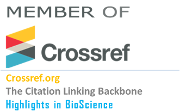Unveiling the architecture variability of coding regions in Prunus persica: Identification and characterization of key gene families impacting plant development
Abstract
Keywords
Full Text:
View Full TextReferences
Meisel L, Fonseca B, González S, Baeza-Yates R, Cambiazo V, Campos R, et al. A rapid and efficient method for purifying high quality total RNA from peaches (Prunus persica) for functional genomics analyses. Biological research. 2005;38(1):83-8.
Durst RW, Weaver GW. Nutritional content of fresh and canned peaches. Journal of the Science of Food and Agriculture. 2013;93(3):593-603.
El-Kahlout MI, Abu-Naser SS. Peach type classification using deep learning. International Journal of Academic Engineering Research (IJAER). 2020;3(12).
Iglesias I, Echeverria G. Current situation, trends and challenges for efficient and sustainable peach production. Scientia Horticulturae. 2022;296:110899.
Liu L, Zheng C, Kuang B, Wei L, Yan L, Wang T. Receptor-like kinase RUPO interacts with potassium transporters to regulate pollen tube growth and integrity in rice. PLoS genetics. 2016;12(7):e1006085.
Preston JC, Hileman LC. Functional evolution in the plant SQUAMOSA-PROMOTER BINDING PROTEIN-LIKE (SPL) gene family. Frontiers in plant science. 2013;4:80.
Kaufmann K, Wellmer F, Muino JM, Ferrier T, Wuest SE, Kumar V, et al. Orchestration of floral initiation by APETALAScience. 2010;328(5974):85-9.
Puranik S, Sahu PP, Srivastava PS, Prasad M. NAC proteins: regulation and role in stress tolerance. Trends in plant science. 2012;17(6):369-81.
Zhong R, Demura T, Ye ZH. SND1, a NAC domain transcription factor, is a key regulator of secondary wall synthesis in fibers of Arabidopsis. The Plant Cell. 2006;18(11):3158-70.
Becraft PW, Stinard PS, McCarty DR. CRINKLY4: a TNFR-like receptor kinase involved in maize epidermal differentiation. Science. 1996;273(5280):1406-9.
Cucinotta M, Manrique S, Guazzotti A, Quadrelli NE, Mendes MA, Benkova E, et al. Cytokinin response factors integrate auxin and cytokinin pathways for female reproductive organ development. Development. 2016;143(23):4419-24.
Chuong EB, Elde NC, Feschotte C. Regulatory activities of transposable elements: from conflicts to benefits. Nature Reviews Genetics. 2017;18(2):71-86.
Becker A, Theißen G. The major clades of MADS-box genes and their role in the development and evolution of flowering plants. Molecular phylogenetics and evolution. 2003;29(3):464-89.
Diao D, Hu X, Guan D, Wang W, Yang H, Liu Y. Genome-wide identification of the ARF (auxin response factor) gene family in peach and their expression analysis. Molecular Biology Reports. 2020;47:4331-44.
Arús P, Verde I, Sosinski B, Zhebentyayeva T, Abbott AG. The peach genome. Tree Genetics & Genomes. 2012;8:531-47.
Swarbreck D, Wilks C, Lamesch P, Berardini TZ, Garcia-Hernandez M, Foerster H, et al. The Arabidopsis Information Resource (TAIR): gene structure and function annotation. Nucleic acids research. 2007;36(suppl_1):D1009-14.
Mahram A, Herbordt MC. NCBI BLASTP on high-performance reconfigurable computing systems. ACM Transactions on Reconfigurable Technology and Systems (TRETS). 2015;7(4):1-20.
Thompson JD, Gibson TJ, Higgins DG. Multiple sequence alignment using ClustalW and ClustalX. Current protocols in bioinformatics. 2003;(1):2-3.
Letunic I, Bork P. Interactive Tree Of Life (iTOL) v4: recent updates and new developments. Nucleic acids research. 2019;47(W1):W256-9.
Alsamman AM, El Allali A, Mokhtar MM, Al-Shamaa K, Nassar AE, Mousa KH, et al. AlignStatPlot: An R package and online tool for robust sequence alignment statistics and innovative visualization of big data. PloS one. 2023;18(9):e0291204.
Barrett T, Wilhite SE, Ledoux P, Evangelista C, Kim IF, Tomashevsky M, et al. NCBI GEO: archive for functional genomics data sets update. Nucleic acids research. 2012;41(D1):D991-5.
Li L, Tao S, Zhang H, Huang W, Dunwell JM, Li M. Identification and characterization of the CCoAOMT gene family in apple, Chinese white pear, and peach. Journal of the American Society for Horticultural Science. 2021;146(3):184-95.
Pegoraro C, Tadiello A, Girardi CL, Chaves FC, Quecini V, Costa de Oliveira A, et al. Transcriptional regulatory networks controlling woolliness in peach in response to preharvest gibberellin application and cold storage. BMC Plant Biology. 2015;15:1-14.
Mering Cv, Huynen M, Jaeggi D, Schmidt S, Bork P, Snel B. STRING: a database of predicted functional associations between proteins. Nucleic acids research. 2003;31(1):258-61.
Smoot ME, Ono K, Ruscheinski J, Wang PL, Ideker T. Cytoscape 2.8: new features for data integration and network visualization. Bioinformatics. 2011;27(3):431-2.
Pei J, Grishin NV. AL2CO: calculation of positional conservation in a protein sequence alignment. Bioinformatics. 2001;17(8):700-12.
Chowdhury B, Garai G. A review on multiple sequence alignment from the perspective of genetic algorithm. Genomics. 2017;109(5-6):419-31.
Li Y, Zhu Y, Yao J, Zhang S, Wang L, Guo C, et al. Genome-wide identification and expression analyses of the homeobox transcription factor family during ovule development in seedless and seeded grapes. Scientific Reports. 2017;7(1):12638.
Arora R, Agarwal P, Ray S, Singh AK, Singh VP, Tyagi AK, et al. MADS-box gene family in rice: genome-wide identification, organization and expression profiling during reproductive development and stress. BMC genomics. 2007;8(1):1-21.
Fang Y, You J, Xie K, Xie W, Xiong L. Systematic sequence analysis and identification of tissue-specific or stress-responsive genes of NAC transcription factor family in rice. Molecular Genetics and Genomics. 2008;280:547-63.
Ohashi-Ito K, Fukuda H. HD-Zip III homeobox genes that include a novel member, ZeHB-13 (Zinnia)/ATHB-15 (Arabidopsis), are involved in procambium and xylem cell differentiation. Plant and Cell Physiology. 2003;44(12):1350-8.
Hirakawa Y, Kondo Y, Fukuda H. TDIF peptide signaling regulates vascular stem cell proliferation via the WOX4 homeobox gene in Arabidopsis. The Plant Cell. 2010;22(8):2618-29.
Xu X, Lou Y, Yang K, Shan X, Zhu C, Gao Z. Identification of homeobox genes associated with lignification and their expression patterns in bamboo shoots. Biomolecules. 2019;9(12):862.
Liu Y, Cui S, Wu F, Yan S, Lin X, Du X, et al. Functional conservation of MIKC*-Type MADS box genes in Arabidopsis and rice pollen maturation. The Plant Cell. 2013;25(4):1288-303.
Alvarez-Buylla ER, Liljegren SJ, Pelaz S, Gold SE, Burgeff C, Ditta GS, et al. MADS-box gene evolution beyond flowers: expression in pollen, endosperm, guard cells, roots and trichomes. The Plant Journal. 2000;24(4):457-66.
Hu J, Chang X, Zhang Y, Yu X, Qin Y, Sun Y, et al. The pineapple MADS-box gene family and the evolution of early monocot flower. Scientific Reports. 2021;11(1):849.
Endo H, Yamaguchi M, Tamura T, Nakano Y, Nishikubo N, Yoneda A, et al. Multiple classes of transcription factors regulate the expression of VASCULAR-RELATED NAC-DOMAIN7, a master switch of xylem vessel differentiation. Plant and Cell Physiology. 2015;56(2):242-54.
Yamaguchi M, Ohtani M, Mitsuda N, Kubo M, Ohme-Takagi M, Fukuda H, et al. VND-INTERACTING2, a NAC domain transcription factor, negatively regulates xylem vessel formation in Arabidopsis. The Plant Cell. 2010;22(4):1249-63.
Zhao C, Lasses T, Bako L, Kong D, Zhao B, Chanda B, et al. XYLEM NAC DOMAIN1, an angiosperm NAC transcription factor, inhibits xylem differentiation through conserved motifs that interact with RETINOBLASTOMA-RELATED. New Phytologist. 2017;216(1):76-89.
Hendelman A, Stav R, Zemach H, Arazi T. The tomato NAC transcription factor SlNAM2 is involved in flower-boundary morphogenesis. Journal of Experimental Botany. 2013;64(18):5497-507.
Takeda S, Hanano K, Kariya A, Shimizu S, Zhao L, Matsui M, et al. CUP-SHAPED COTYLEDON1 transcription factor activates the expression of LSH4 and LSH3, two members of the ALOG gene family, in shoot organ boundary cells. The Plant Journal. 2011;66(6):1066-77.
Xiang Y, Cao Y, Xu C, Li X, Wang S. Xa3, conferring resistance for rice bacterial blight and encoding a receptor kinase-like protein, is the same as XaTheoretical and Applied Genetics. 2006;113:1347-55.
Zhang X, Wang L, Yuan Y, Tian D, Yang S. Rapid copy number expansion and recent recruitment of domains in S-receptor kinase-like genes contribute to the origin of self-incompatibility. The FEBS Journal. 2011;278(22):4323-37.
Saintenac C, Lee WS, Cambon F, Rudd JJ, King RC, Marande W, et al. Wheat receptor-kinase-like protein Stb6 controls gene-for-gene resistance to fungal pathogen Zymoseptoria tritici. Nature genetics. 2018;50(3):368-74.
Zhao D, Ni W, Feng B, Han T, Petrasek MG, Ma H. Members of the Arabidopsis-SKP1-like gene family exhibit a variety of expression patterns and may play diverse roles in Arabidopsis. Plant physiology. 2003;133(1):203-17.
Zhao L, Huang J, Zhao Z, Li Q, Sims TL, Xue Y. The Skp1-like protein SSK1 is required for cross-pollen compatibility in S-RNase-based self-incompatibility. The Plant Journal. 2010;62(1):52-63.
Kaur C, Sharma S, Singla-Pareek SL, Sopory SK. Methylglyoxal, triose phosphate isomerase, and glyoxalase pathway: implications in abiotic stress and signaling in plants. Elucidation of Abiotic Stress Signaling in Plants: Functional Genomics Perspectives, Volume 2015:347-66.
Chen M, Liu X, Jiang S, Wen B, Yang C, Xiao W, et al. Transcriptomic and functional analyses reveal that PpGLK1 regulates chloroplast development in peach (Prunus persica). Frontiers in Plant Science. 2018;9:34.
Testone G, Condello E, Verde I, Nicolodi C, Caboni E, Dettori MT, et al. The peach (Prunus persica L. Batsch) genome harbours 10 KNOX genes, which are differentially expressed in stem development, and the class 1 KNOPE1 regulates elongation and lignification during primary growth. Journal of experimental botany. 2012;63(15):5417-35.
Wuddineh WA, Mazarei M, Zhang JY, Turner GB, Sykes RW, Decker SR, et al. Identification and overexpression of a Knotted1-like transcription factor in switchgrass (Panicum virgatum L.) for lignocellulosic feedstock improvement. Frontiers in plant science. 2016;7:520.
DOI: https://doi.org/10.36462/H.BioSci.202302
Refbacks
- There are currently no refbacks.
Copyright (c) 2023 Rizk

This work is licensed under a Creative Commons Attribution 4.0 International License.
...........................................................................................................................................................
Other "Highlights in" Journals
Highlights in Bioinformatics, Highlights in Chemistry, Highlights in Science, Highlights in Microbiology, Highlights in Plant Science
........................................................................................................................................
International Library of Science "HighlightsIn" is an Open Access Scientific Publishers, aiming to science and knowledge support













